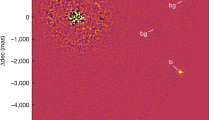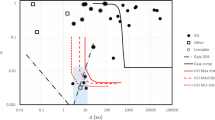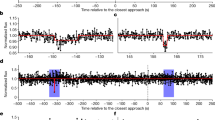Abstract
The systems of satellites and rings surrounding the giant planets in the Solar System have remarkably similar architectures1. Closest to each planet are rings with associated moonlets, then larger ‘regular’ satellites on nearly circular orbits close to the planet's equatorial plane, and finally one or more distant, small ‘irregular’ satellites on highly elliptical or inclined orbits. Hitherto, the only departure from this broad classification scheme was the satellite system around Uranus, in which no irregular satellites had been found2. Here we report the discovery of two satellites orbiting Uranus at distances of several hundred planetary radii. These satellites have inclined, retrograde orbits of moderate eccentricity that clearly identify them as irregular. The satellites are extremely faint (apparent red magnitudes mR = 20.4 and 21.9), with estimated radii of only 60 and 30 km. Both moons are unusually red in colour, suggesting a link between these objects—which were presumably captured by Uranus early in the Solar System's history—and other recently discovered bodies3 orbiting in the outer Solar System.
This is a preview of subscription content, access via your institution
Access options
Subscribe to this journal
Receive 51 print issues and online access
$199.00 per year
only $3.90 per issue
Buy this article
- Purchase on Springer Link
- Instant access to full article PDF
Prices may be subject to local taxes which are calculated during checkout

Similar content being viewed by others
References
Burns, J. A. in Satellites (eds Burns, J. A. & Matthews, M. S.) 1–38 (Univ. Arizona Press, Tucson, 1986).
Pollack, J. B., Lunine, J. & Tittemore, W. C. in Uranus (eds Bergstrahl, J. T., Miner, E. D. & Matthews, M. S.) 469–512 (Univ. Arizona Press, Tucson, 1991).
Jewitt, D., Luu, J. & Chen, J. The Mauna Kea-Cerro Tololo Kuiper belt and Centaur survey. Astron. J. 112, 1225–1238 (1996).
Kowal, C. T., Aksnes, K., Marsden, B. G. & Roemer, E. Thirteenth satellite of Jupiter. Astron. J. 80, 460–464 (1975).
Pickering, W. H. Ann. Harvard Coll. Obs. 53, 45–73, 85–142 (1905).
Kuiper, G. The second satellite of Neptune. Publ. Astron. Soc. Pacif. 61, 175–176 (1949).
Pollack, J. B., Burns, J. A. & Tauber, M. E. Gas drag in primordial circumplanetary envelopes: A mechanism for satellite capture. Icarus 37, 587–611 (1979).
Kuiper, G. in Planets and Satellites (eds Kuiper, G. & Middlehurst, B. M.) 575–591 (Univ. Chicago Press, Chicago, 1961).
Owen, W. M. J & Synnott, S. P. Orbits of the ten small satellites of Uranus. Astron. J. 93, 1268–1271 (1987).
Christie, W. Report on a search for further satellites of the planets Uranus and Neptune. Publ. Astron. Soc. Pacif. 42, 253 (1930).
Smith, B. in Uranus and Neptune (ed. Bergstralh, J. T.) 213–223 (CCP-2330, NASA, Washington DC, 1984).
Cruikshank, D. P. & Brown, R. H. in Satellites (eds Burns, J. A. & Matthews, M. S.) 836–873 (Univ. Arizona Press, Tucson, 1986).
Żytkow, A., Irwin, M., Webster, R. & Tremaine, S. Aphotographic search for satellites of Uranus. Icarus 102, 298–306 (1993).
Greenberg, R., Bottke, W. F., Carusi, A. & Valsecchi, G. B. Planetary accretion rates: Analytical derivation. Icarus 94, 98–111 (1991).
Hamilton, D. P. & Krivov, A. V. Dynamics of distant moons of asteroids. Icarus 128, 241–249 (1997).
Goldreich, P. Inclination of satellite orbits about an oblate precessing planet. Astron. J. 70, 5–9 (1966).
Gladman, B. & Kavelaars, J Kuiper belt searches from the Palomar 5-m telescope. Astron. Astrophys. 317, 35–38 (1997).
Luu, J. Twice in a blue moon. Nature 390, 441–443 (1997).
Gladman, B. et al. IAU Circ. No. 6764 ((1997).
Fitzsimmons, A., Fletcher, M., Irwin, M., Offut, W. & Hergenrother, C. IAU Circ. No. 6771 ((1997).
Marsden, B. & Williams, G. V. IAU Circ. No. 6780 ((1997).
Marsden, B. & Williams, G. V. IAU Circ. No. 6765 ((1997).
Thomas, F. & Morbidelli, A. The Kozai resonance in the outer solar system and the dynamics of long-period comets. Celest. Mech. Dyn. Astron. 64, 209–229 (1996).
Thomas, P. C., Weitz, C. & Veverka, J. Small satellites of Uranus: Disk-integrated photometry and estimated radii. Icarus 81, 92–101 (1989).
Thomas, P. C., Veverka, J. & Helfenstein, P. Voyager observations of Nereid. J. Geophys. Res. 96, 19253–19259 (1991).
Veverka, J., Brown, R. H. & Bell, J. F. in Uranus (eds Bergstrahl, J. T., Miner, E. D. & Matthews, M. S.) 528–560 (Univ. Arizona Press, Tucson, 1991).
Cruikshank, D. P. Near-infrared studies of the satellites of Saturn and Uranus. Icarus 41, 246–253 (1980).
Tholen, D. J. & Zellner, B. Eight-color photometry of Hyperion, Iapetus and Phoebe. Icarus 53, 341–347 (1983).
Tholen, D. J. & Zellner, B. Multicolor photometry of outer jovian satellites. Icarus 58, 246–253 (1984).
Luu, J. & Jewitt, D. Color diversity among the Centaurs and Kuiper belt objects. Astron. J. 112, 2310–2318 (1996).
Green, S. F. et al. Surface reflectance properties of distant solar system bodies. Mon. Not. R. Astron. Soc. 290, 186–192 (1997).
Fink, U. et al. The steep red spectrum of 1992 AD: An asteroid covered with organic material? Icarus 97, 145–149 (1992).
Wilson, P. D. Models of Organic-Rich Surfaces in the Outer Solar System.Thesis, Cornell Univ.((1997).
Acknowledgements
Observations at the Palomar Observatory were made as part of a continuing collaborative agreement between the California Institute of Technology and Cornell University. We thank the telescope operators and mountain staff at Palomar for their assistance; D. Tholen, A. Fitzsimmons, C.Hergenrother and S. Lilly for their confirming observations; and T. Yokoyama for numerical integrations of the provisional orbits. Support came from the Natural Sciences and Engineering Research Council of Canada (B.G. and JJK.), and NASA's Planetary Geology and Geophysics program (P.D.N. and J.A.B.).
Author information
Authors and Affiliations
Corresponding author
Rights and permissions
About this article
Cite this article
Gladman, B., Nicholson, P., Burns, J. et al. Discovery of two distant irregular moons of Uranus. Nature 392, 897–899 (1998). https://doi.org/10.1038/31890
Received:
Accepted:
Issue Date:
DOI: https://doi.org/10.1038/31890
This article is cited by
-
Irregular Satellites of Jupiter: a study of the capture direction
Earth, Moon, and Planets (2007)
-
Irregular Satellites in the Context of Planet Formation
Space Science Reviews (2005)
-
Discovery of five irregular moons of Neptune
Nature (2004)
-
Jupiter's moonopoly
Nature (2003)
-
Saturn saturated with satellites
Nature (2001)
Comments
By submitting a comment you agree to abide by our Terms and Community Guidelines. If you find something abusive or that does not comply with our terms or guidelines please flag it as inappropriate.



